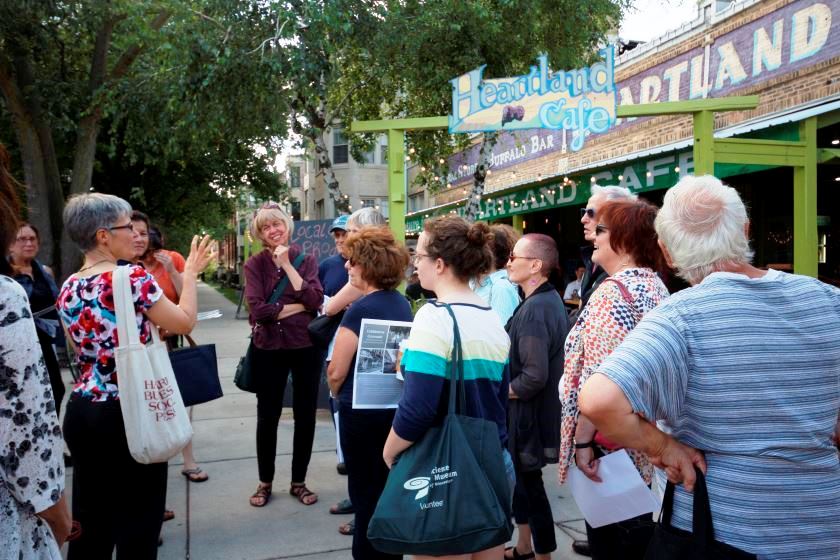archive
Loyola Public History Graduate Students Making an Impact in Chicago Neighborhoods

Photography courtesy of David Kogan.
On August 23, 2015, Loyola history master’s student Kristin Jacobsen led a walking tour of the Glenwood Avenue Arts District in Chicago’s Rogers Park neighborhood for the Rogers Park/West Ridge Historical Society (RP/WRHS). Her walking tour stemmed from projects undertaken by student groups in Dr. Patricia Mooney-Melvin’s graduate Public History Methods and Theory course (HIST 480) during the fall 2014 semester. For the project, HIST 480 students produced walking tour scripts about Rogers Park and West Ridge history for the RP/WRHS. Jacobsen’s group, which also included master’s students Blake Kennedy, Lauren O'Brien, and Andrew Paddock, produced a tour that explored Rogers Park’s Glenwood Avenue Arts District and presented the concept to the RP/WRHS President and Vice-President in December 2014. Jacobsen agreed to lead the tour for RP/WRHS members the following August.
PhD student Hope Shannon talked to Jacobsen about her experience.
HS: How did you come to lead a walking tour for the RP/WRHS?
KJ: The tour was developed as an assignment for Prof. Mooney-Melvin’s class, Public History: Method and Theory. The class was divided into groups, and each group was asked to develop a tour on an aspect of Rogers Park. My group chose the Glenwood Avenue Arts District. The assignment felt much more dynamic than most class work because of the possibility that the tour we were developing could become a reality, something that would both benefit the community and give students experience as public historians.
HS: Why did your group select the Glenwood Avenue Arts District for your tour?
KJ: We chose the Glenwood Avenue Arts District for the tour because it helps give the neighborhood a rich and unique character in the city. We thought that the connection between art and community in Rogers Park should be highlighted and that it also could help attract people to the neighborhood. I’ve lived in the Chicago area for a long time and have come back again and again to Rogers Park for its theaters and restaurants, even before I became a graduate student at Loyola. My group of public history students also was attracted to the fact that this recent history did not have any official record, and we could help gather information before it became lost.
HS: How did you conduct the research for this project?
KJ: We conducted research using a variety of methodologies and sources. We did traditional textual research to establish background on the history of Rogers Park and on the development of the performing and visual arts since the 1960s. We also interviewed founders of the Glenwood Avenue Arts District and long-time restaurant and theater directors. One member looked at building permits for clues about changes in the buildings on the tour. Several other members looked in the holdings of the Rogers Park/West Ridge Historical Society for information, photos, and supplementary materials to use for the tour.
HS: How did this experience complement or inform what you learned in your public history coursework?
KJ: We experienced first hand the engagement with the community that is a critical part of public history, and we felt pride in helping preserve an aspect of that community. We also learned about the challenges of gathering information that is thinly covered in official sources. It was real-world work that had real-world benefits outside the classroom and outside of academia in general. The project also could be taken further. If there are public history students interested in using digital media, they could explore with the historical society the issues and feasibility of recording the tour script and putting it online.
Students completed two projects during the fall 2014 HIST 480 class. In addition to creating walking tours, students worked on a project about the Chrysler Village Historic District. Both assignments were designed and coordinated by Loyola Public History PhD students-- the walking tour project by PhD student Hope Shannon and the Chrysler Village project by PhD candidate Rachel Boyle. For the Chrysler Village project, students developed proposals that suggested how to turn research gathered for the Chrysler Village National Register of Historic Places nomination into initiatives and programming that would benefit residents living in and around Chrysler Village.
The walking tour project originated from the ongoing partnership between the Public History Lab and the RP/WRHS. Founded by Loyola history graduate students in fall 2013, the Public History Lab is a Loyola history graduate student-run effort that provides history graduate students with opportunities to use and build professional skills at history organizations and sites of history in the Chicago area. Graduate students involved with Public History Lab began volunteering with the RP/WRHS in fall 2013. In January 2015, after the end of the 480 course, Rachel Boyle and students from the 480 class decided to continue the Chrysler Village project, beginning Public History Lab’s second official initiative.

